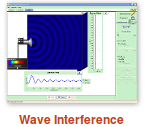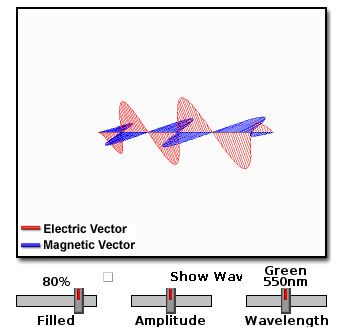Difference between revisions of "Nature of Light"
| Line 164: | Line 164: | ||
#[http://www.youtube.com/watch?v=CN-wjj_phVA Thomas Young's Double Slit Experiment] | #[http://www.youtube.com/watch?v=CN-wjj_phVA Thomas Young's Double Slit Experiment] | ||
| − | ===Activity No # 1 - Simulation of double slit experiment=== | + | ===Activity No # 1- Reflection, Refraction and Diffraction as waves=== |
| + | {| style="height:10px; float:right; align:center;" | ||
| + | |<div style="width:150px;border:none; border-radius:10px;box-shadow: 5px 5px 5px #888888; background:#f5f5f5; vertical-align:top; text-align:center; padding:5px;"> | ||
| + | ''[http://karnatakaeducation.org.in/?q=node/305 Click to Comment]''</div> | ||
| + | |} | ||
| + | The objective is to demonstrate how we can explain the phenomena of light - reflection, refraction - through the wave model. | ||
| + | The teacher must reconcile the rays to the wave model. | ||
| + | * '''Estimated Time''' - 40 minutes | ||
| + | * '''Materials/ Resources needed'''<br> | ||
| + | Computer, Projector, Blackboard | ||
| + | * '''Prerequisites/Instructions, if any'''<br> | ||
| + | Simulation of the double slit experiment | ||
| + | * '''Multimedia resources''' | ||
| + | * '''Website interactives/ links/ simulations''' | ||
| + | {|class="wikitable" | ||
| + | |- | ||
| + | |[[File:Reflection_and_refraction.png|300px|link=http://www.olympusmicro.com/primer/java/reflection/huygens/index.html]] | ||
| + | |[[File:diffraction.png|300px|link=http://www.olympusmicro.com/primer/java/diffraction/index.html]] | ||
| + | |} | ||
| + | <br>Source:[http://www.olympusmicro.com/ Olympus Microscopy Centre] | ||
| + | * '''Process (How to do the activity)''' | ||
| + | After discussing the simulation, explain the process of reflection and refraction in waves | ||
| + | * '''Developmental Questions (What discussion questions)''' | ||
| + | #Have you seen any waves? | ||
| + | #When they encounter an obstruction what do they do? (They bounce back, they bend around, etc_ | ||
| + | #In this image, what do you see happening to the wavefronts - they get reflected, they get refracted | ||
| + | #How can we represent this using a ray diagram? | ||
| + | * '''Evaluation (Questions for assessment of the child)''' | ||
| + | Observe the student response to above questions | ||
| + | * '''Question Corner''' | ||
| + | |||
| + | |||
| + | ===Activity No # 2 - Simulation of double slit experiment=== | ||
{| style="height:10px; float:right; align:center;" | {| style="height:10px; float:right; align:center;" | ||
|<div style="width:150px;border:none; border-radius:10px;box-shadow: 5px 5px 5px #888888; background:#f5f5f5; vertical-align:top; text-align:center; padding:5px;"> | |<div style="width:150px;border:none; border-radius:10px;box-shadow: 5px 5px 5px #888888; background:#f5f5f5; vertical-align:top; text-align:center; padding:5px;"> | ||
| Line 192: | Line 224: | ||
* '''Question Corner''' | * '''Question Corner''' | ||
| − | ===Activity No # | + | ===Activity No # 3- Explain the double slit experiment=== |
{| style="height:10px; float:right; align:center;" | {| style="height:10px; float:right; align:center;" | ||
|<div style="width:150px;border:none; border-radius:10px;box-shadow: 5px 5px 5px #888888; background:#f5f5f5; vertical-align:top; text-align:center; padding:5px;"> | |<div style="width:150px;border:none; border-radius:10px;box-shadow: 5px 5px 5px #888888; background:#f5f5f5; vertical-align:top; text-align:center; padding:5px;"> | ||
| Line 214: | Line 246: | ||
#The interaction between two waves is called interference | #The interaction between two waves is called interference | ||
#This can be constructive or destructive interference | #This can be constructive or destructive interference | ||
| − | |||
| − | |||
| − | |||
| − | |||
| − | |||
| − | |||
| − | |||
| − | |||
| − | |||
| − | |||
| − | |||
| − | |||
| − | |||
| − | |||
| − | |||
| − | |||
| − | |||
| − | |||
| − | |||
| − | |||
| − | |||
| − | |||
| − | |||
| − | |||
| − | |||
| − | |||
| − | |||
| − | |||
| − | |||
| − | |||
| − | |||
* '''Evaluation (Questions for assessment of the child)''' | * '''Evaluation (Questions for assessment of the child)''' | ||
Observe the student response to above questions | Observe the student response to above questions | ||
Revision as of 17:10, 20 January 2014
| Philosophy of Science |
While creating a resource page, please click here for a resource creation checklist
Concept Map
Error: Mind Map file Nature_of_Light.mm not found
Textbook
To add textbook links, please follow these instructions to: (Click to create the subpage)
Additional information
Useful websites
- Interactive Simulation on Nature of Light

In this simulation, you can explore the history of quantum physics, how the understanding of light was developed and an overview of the theories of light. Source: NSTA - Interactive Simulation on Nature of Light

In this simulation you can explore the behaviour of light as waves. Source: NSTA - Wikipedia article on Wave Particle Duality
- Web interactives and additional information on Physics of Light and Colour; Source: Olympus Microscopy Research
- Physics Classroom-Electromagnetic Waves
- Physics Classroom-Wavelike Properties of Light
- Physics Classroom - Electromagnetic Radiation and Visible Spectra
Reference Books
- E=m by David Bodanis - This book is a very interesting account of how the understanding developed in quantum physics and the theory of light. See Online
- NCERT Textbook Chapter Light
- NCERT Textbook Chapter Reflection and Refraction
- NCERT Textbook Chapter Human Eye and the Colourful World
An image of a concept map of light
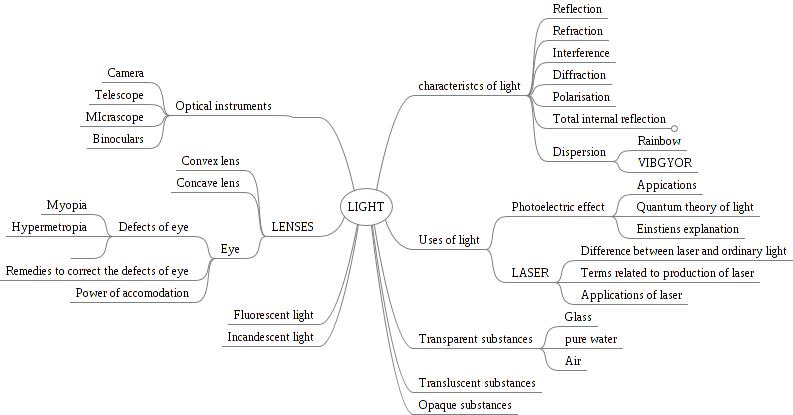
Teaching Outlines
Concept #1 - White Light is made up of colours
Learning objectives
- White Light is made up of seven constituent colours
- Introduction to the corpuscular theory of light
Notes for teachers
Reinforce the learning from activity on Recombination of Colours. Also understand the model as proposed by Newton on the nature of light and examine the limitations of this theory.
| LCs8mK1rzc0|150|left}} Primary Additive Colours |
r8ejTUNwgTo|150|left}} Primary Subtractive Colours |
Activity No # 1A - Using a prism to split and combine white light
- Estimated Time - 2 periods of 40 minutes
- Materials/ Resources needed
White paper, Pins, Source of Light, Prisms, Dark room
- Prerequisites/Instructions, if any
- Activity on Recombination of Colours
- Dark room for light experiments
- Multimedia resources
- Website interactives/ links/ simulations
| Newton's Prism Experiment. This is a demonstration of the experiment showing the splitting and recombination of white light. Useful to show the students after the demonstration/ experimentation in class. |
- Process (How to do the activity)
- Demonstrate the dispersion using a prism and recombination of the light
- Students must do this experiment in groups
- The teacher must demonstrate carefully how to position the prism, how to observe rays in light experiments
- Students must be able to draw ray diagrams showing the split of the spectrum
- Developmental Questions (What discussion questions)
- When the light falls on the prism, what did you expect to see? What happened?
- What are the colours you see? What is the order of the colours?
- Evaluation (Questions for assessment of the child)
- From the incoming beam of light, which colour showed the maximum angle of dispersion? (This question can be picked up later to discuss wavelengths and electromagnetic spectrum)
- If you change the direction of the incoming light, what happens to the dispersion?
- Observe the accuracy of the diagrams
- Question Corner
Activity No # 1B - What is colour
The objective is to understand colours as different wavelengths associated with light.
- Estimated Time - 30 minutes
- Materials/ Resources needed
Computer, projector, power
- Prerequisites/Instructions, if any
- Multimedia resources
- Website interactives/ links/ simulations
- Process (How to do the activity)
Watch the video and discuss with the student their understanding.
- Developmental Questions (What discussion questions)
- How does a wave move? The vocabulary is wave propagation)
- What gets transmitted?
- What can you say about the wave when the frequency is high?
- What can you say about the wave when the wavelength is high?
- It is possible to look at light as a wave; the waves are not of material objects but travelling waves changing electric and magnetic fields.
- Different wavelengths are associated with different energy levels and different kind of radiation(light is a form of electromagnetic radiation; there are other electromagnetic radiations)
- The higher the frequency the higher the energy; this is seen as different colours of the visible spectrum
- Can we break down these seven colours more? (No; demonstrate with a prism; these are pure colours)
- Evaluation (Questions for assessment of the child)
Draw a ray diagram to show how this theory explains reflection.
- Question Corner
Activity No # 1C - Corpsucular Theory of Light
The objective is to study Newton's theory on light
- Estimated Time - 30 minutes
- Materials/ Resources needed
Computer, projector, power
- Prerequisites/Instructions, if any
- Multimedia resources
- Website interactives/ links/ simulations
- Process (How to do the activity)
Watch the video and discuss with the student their understanding.
- Developmental Questions (What discussion questions)
- Can reflection and refraction be explained using this? How?
- Newton said that different colours can be caused by different sizes of particles. Knowing what you know of the eye, explain how this would have worked.
- What do you not understand about this theory based on your observations?
- Evaluation (Questions for assessment of the child)
Draw a ray diagram to show how this theory explains reflection.
- Question Corner
Concept #2 - Wave Nature of Light
Learning objectives
- Light behaves like waves
- Light undergoes reflection, refraction, interference and diffraction - all those that we associate with waves
- Light is an electromagnetic radiation that travels as a wave and does not need a medium
- As in any other wave, the energy depends on the frequency of the wave
- When light waves are of different wavelengths, they are seen as different colours
Notes for teachers
Studies done on how light travels has helped us visualise it now as changing electrical magnetic fields that interact with other material objects as packets of energy. This radiation can be thought of as waves of different wavelengths. The waves are not of material objects but travelling waves changing electric and magnetic fields. Different wavelengths are associated with different energy levels and different kind of radiation.
Click here for more notes on the nature of light, visible light and colours.
Videos on Nature of Light
The following videos are useful in understanding the nature of light.
Activity No # 1- Reflection, Refraction and Diffraction as waves
The objective is to demonstrate how we can explain the phenomena of light - reflection, refraction - through the wave model. The teacher must reconcile the rays to the wave model.
- Estimated Time - 40 minutes
- Materials/ Resources needed
Computer, Projector, Blackboard
- Prerequisites/Instructions, if any
Simulation of the double slit experiment
- Multimedia resources
- Website interactives/ links/ simulations
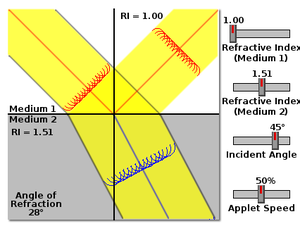
|
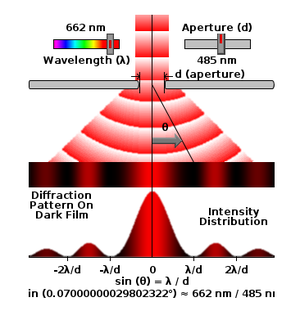
|
Source:Olympus Microscopy Centre
- Process (How to do the activity)
After discussing the simulation, explain the process of reflection and refraction in waves
- Developmental Questions (What discussion questions)
- Have you seen any waves?
- When they encounter an obstruction what do they do? (They bounce back, they bend around, etc_
- In this image, what do you see happening to the wavefronts - they get reflected, they get refracted
- How can we represent this using a ray diagram?
- Evaluation (Questions for assessment of the child)
Observe the student response to above questions
- Question Corner
Activity No # 2 - Simulation of double slit experiment
The objective of this activity is to demonstrate an important experiment from the 18th century that made physicists rethink about the nature of light. Until this time, Newton's corpuscular theory was used to explain light.
- Estimated Time
- Materials/ Resources needed
- Prerequisites/Instructions, if any
- Multimedia resources
- Website interactives/ links/ simulations
- Process (How to do the activity)
- Launch the simulation from the PhET website or download it and run. #Discuss the simulation with the following questions.
- Do the simulation with water and then light. You can do sound if students have been introduced to material waves and understand sound. It is better to do another simulation on wave propagation on sound before doing this simulation.
- Developmental Questions (What discussion questions)
- Let us click on water here. When a drop of water drips in a bucket, what do you expect to see (waves move around)
- If two drops of water drip, what do you expect to see (the patterns the water make will intersect; this is called interference)
- Now let us do a similar thing with light
- What do you see now from the source of the light? (Light emanating)
- If I put one slit, what will I expect to see, according to the ray theory of light? (There will be a dark spot where the slit is but rest of the screen will have light)
- If I have two slits, what will I expect to see?
- What do we really observe? Why would this be?
- Talk about how waves propagate and what happens when there is interference?
- Evaluation (Questions for assessment of the child)
- Question Corner
Activity No # 3- Explain the double slit experiment
- Estimated Time - 40 minutes
- Materials/ Resources needed
Computer, Projector, Blackboard
- Prerequisites/Instructions, if any
Simulation of the double slit experiment
- Multimedia resources
- Website interactives/ links/ simulations
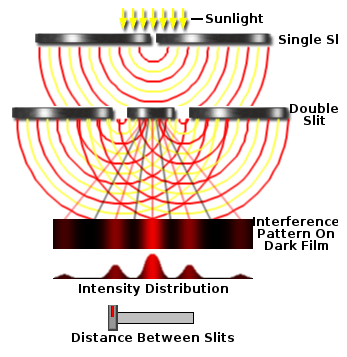
Source:Olympus Microscopy Centre
- Process (How to do the activity)
After discussing the simulation, explain the process of interference in waves
- Developmental Questions (What discussion questions)
- What is a wave? (carries energy)
- Can two waves meet? (Water, ropes etc)
- What happens when they meet? The energy increases or decreased
- The interaction between two waves is called interference
- This can be constructive or destructive interference
- Evaluation (Questions for assessment of the child)
Observe the student response to above questions
- Question Corner
Concept # 3- Dual Nature of Light
Learning objectives
- It is possible to look at light and other electro magnetic radiation as a wave or as a particle known as the photon.
- Light travels as electromagnetic radiation; with waves of different wavelengths
- Light interacts with material particles in discrete packets called photons
- Different wavelengths are associated with photons of different energies
Notes for teachers
The objective here is to enable students to understand that light can be thought of as a wave or as particles. Different models of light explain different phenomena. It is important to get a sense of the history of how light was understood, how electromagnetism was understood and how light is the result of continuously oscillating electric and magnetic fields.
Activity No #1 - Introduce the nature of electromagnetic radiation
- Estimated Time
- Materials/ Resources needed
- Prerequisites/Instructions, if any
- Multimedia resources
- Website interactives/ links/ simulations
- Process (How to do the activity)
- Developmental Questions (What discussion questions)
- Evaluation (Questions for assessment of the child)
- Question Corner
Activity No #
- Estimated Time
- Materials/ Resources needed
- Prerequisites/Instructions, if any
- Multimedia resources
- Website interactives/ links/ simulations
- Process (How to do the activity)
- Developmental Questions (What discussion questions)
- Evaluation (Questions for assessment of the child)
- Question Corner
Concept #4 Electromagnetic Spectrum
| CCAYcuCWOnM|150|left}} Introduction |
OzDmEA8x0nQ|150|left}} Radio Waves |
UZeBzTI5Omk|150|left}} Microwaves |
i8caGm9Fmh0|150|left}} Infrared waves |
| PMtC34pzKGc|150|left}} Visible Light Waves |
QW5zeVy8aE0|150|left}} Ultraviolet rays |
CCAYcuCWOnM|150|left}} X Rays |
TA5SLDiIUWs|150|left}} Gamma waves |
Learning objectives
Notes for teachers
These are short notes that the teacher wants to share about the concept, any locally relevant information, specific instructions on what kind of methodology used and common misconceptions/mistakes.
Activity No #
- Estimated Time
- Materials/ Resources needed
- Prerequisites/Instructions, if any
- Multimedia resources
- Website interactives/ links/ simulations
- Process (How to do the activity)
- Developmental Questions (What discussion questions)
- Evaluation (Questions for assessment of the child)
- Question Corner
Activity No #
- Estimated Time
- Materials/ Resources needed
- Prerequisites/Instructions, if any
- Multimedia resources
- Website interactives/ links/ simulations
- Process (How to do the activity)
- Developmental Questions (What discussion questions)
- Evaluation (Questions for assessment of the child)
- Question Corner
Project Ideas
Fun corner
Usage
Create a new page and type {{subst:Content}} to use this template
- It is possible to look at light and other electro magnetic radiation as a wave or as a particle known as the photon.
- Light travels as electromagnetic radiation; with waves of different wavelengths
- Light interacts with material particles in discrete packets called photons
- Different wavelengths are associated with photons of different energies

